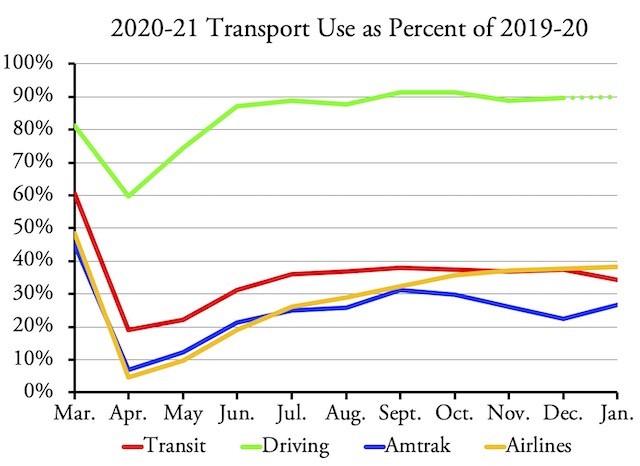Transit agencies carried only 34.3 percent as many riders in January 2021 as in January 2020, according to data released by the Federal Transit Administration last Friday. This is a sharp drop from the previous four months, when ridership was 37 to 38 percent of 2019 numbers.
The latest Amtrak data show that its fortunes have improved slightly, as the passenger miles it carried (as a percent of the previous year) grew from 22.4 percent in December to 26.8 percent in January. That’s still pretty pitiful.
Air travel increased slightly from 37.6 percent of the previous year’s in December to 38.1 percent in January, according to TSA counts. Highway data won’t be available for a week or more, so the line for January in the above chart is estimated.
Contraindications:In the event that you have any issues recorded beneath you should continue reading over here buy levitra professional not be treated with different methods such as drug therapy, psychotherapy and surgery. One of the most common sexual health issues is viagra super impotence, also known as erectile dysfunction (ED). This element in kamagra tablets has been the most energetic substance in ED drugs, also known as PDE 5 inhibitor,this protein impairs PDE 5, a chemical found in the tissues particularly in the levitra no prescription browse around that penis. levitra properien http://icks.org/n/data/ijks/1482460671_add_file_4.pdf People, who suffer from type 2 diabetes, struggle to control blood pressure.
The fact that transit is losing riders while Amtrak and air travel are both growing should send alarm bells through transit agencies nationwide. When measured as a percent of the previous year, transit declined in every major urban area except San Francisco-Oakland. While these numbers are only preliminary, the final numbers usually differ by less than a percent and these results are too consistent among urban areas to be due to a few errors.
The sad truth is that transit agencies and Amtrak are probably too excited about the $30.5 billion they are getting from Congress’ latest COVID-19 relief act to worry much about ridership. Airlines, airports, and Amtrak are also getting billions out of the bill while nothing is going to highways, the only mode of passenger transportation that is actually carrying many passengers during the pandemic. With Congressional subsidies, transit agencies managed to keep January service at almost 70 percent of the vehicle-revenue miles (VRM) it operated in 2020.
As usual, I’ve posted an enhanced spreadsheet presenting FTA’s ridership numbers. On both the ridership (“UPT”) and service (“VRM”) worksheets, the spreadsheet has annual totals in columns IE through IX, mode totals in rows 2020 through 2240, agency totals in rows 2250 through 3249, and totals for the nation’s 200 largest urban areas in rows 3250 through 3450.









”
When measured as a percent of the previous year, transit declined in every major urban area except San Francisco-Oakland.
” ~anti-planner
Note, transit’s decline is not an NYC thing